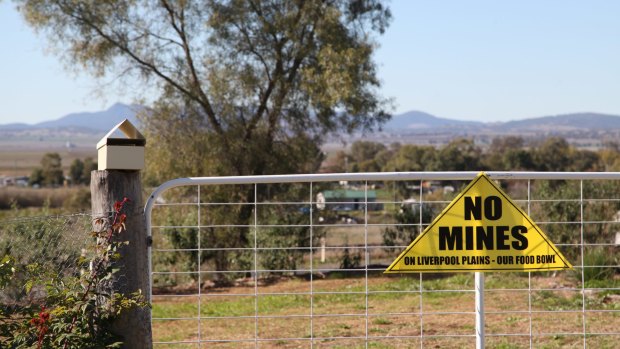This was published 3 years ago
US funds titan BlackRock 'deeply concerned' about NSW coal mine
The world's largest asset manager says it is deeply concerned about the looming destruction of ancient Aboriginal artefacts by a Chinese coal producer it has invested in with controversial plans for a mine in regional NSW.
New York-based asset management titan BlackRock confirmed it holds about 202 million Hong Kong-listed shares in China Shenhua Energy, the world's largest thermal coal producer, worth approximately $474 million at current prices. About 1 million of these shares are held by BlackRock's Australian arm.

The Shenhua mine in northern NSW has been opposed by farmers and traditional owners. Credit: Kate Ausburn
The Chinese company is planning to mine a site near Gunnedah in northern NSW against the wishes of its traditional owners, the Gomeroi people. The open-cut coal mine site contains ancient grinding grooves that show where First Nations warriors sharpened spears as well as burial sites and sacred trees.
"BlackRock is deeply concerned with this matter and will continue to engage with companies on environmental and social issues - including the protection of Indigenous heritage sites across miners’ operations," a fund spokesman said.
BlackRock, which oversees $US6.47 trillion ($9.3 trillion) of investments for a range of institutions including Australian superannuation firms and the Future Fund, said it had divested from China Shenhua Energy in its actively managed portfolios, and only retained shares in passive index tracking funds.
The Age and Herald this week revealed BlackRock and CBUS, the superannuation fund for the construction industry, both have money invested in China Shenua Energy, which is majority owned by the Chinese government but listed in both Hong Kong and Shanghai.
CBUS, which has a $4.5 million stake in the company, also defended its investment arguing it is passively held in index funds. But executive director of the Australasian Centre for Corporate Responsibility Brynn O'Brien said this response was inadequate.
"If that is going to be the justification given by funds, their members should know that," Ms O'Brien said.
BlackRock and CBUS have both claimed to be "responsible investors" putting environmental, social and governance standards at the heart of investment choices. However, CBUS did not answer questions about whether it had engaged with China Shenhua over the planned destruction of the artefacts or the broader climate change implications of the mine.
China Shenhua's plans to extract 10 million tonnes of thermal coal annually from the mine have been fiercely opposed by local agricultural, environment and Indigenous groups since plans were first floated in 2008.
The Gomeroi last month filed legal submissions against the federal government in an attempt to get the mine's approval in 2015 overturned.
Scrutiny over mining of ancient Aboriginal sites has come into sharp focus after resources giant Rio Tinto destroyed 46,000-year-old caves in Western Australia's Pilbara region despite opposition from the site's traditional owners.
Farmer John Hamparsum's family has owned a 1500 hectare property that neighbours the Shenhua mine since 1961 and had no idea Australian superannuation funds had a stake in the company behind the mine.
"I always thought the Shenhua Watermark project was completely funded by China, I didn’t realise there were other investors in it," Mr Hamparsum said.
"Most people wouldn't know where their superannuation money is being invested other than their risk profile ... Australian super funds should not be invested in this. At all."
The mine would permanently damage and restrict the groundwater used to service the valuable black agricultural soils of the Liverpool plains and drive up water prices for local farmers, Mr Hamparsum said. "It’s a 30 year mine but the impact is forever."
China Shenhua proposed lifting sandstone slabs to relocate some of the Indigenous artefacts but Tim Owen, principal of archaeological consultancy firm GML Heritage, said the company's own report found the rock was too fragile and would break, destroying the artefacts.
The proposed relocation site for the grooves was also on the grounds of where an Indigenous massacre occurred around 1830, he said.
"This is now a remembrance ground. It’s a place of remembrance of atrocities perpetrated to their people. Those wounds are fresh in their memory," Dr Owen said. "I can't see how this plan is appropriate in any way shape or form."
Get our Morning & Evening Edition newsletters
The most important news, analysis and insights delivered to your inbox at the start and end of each day. Sign up to The Sydney Morning Herald’s newsletter here and The Age’s newsletter here.